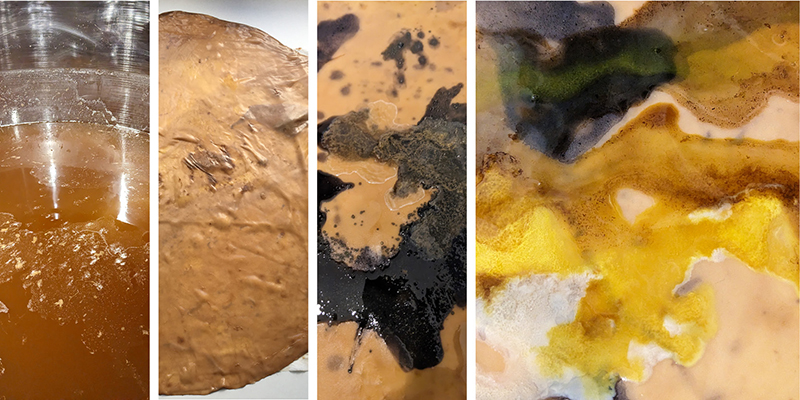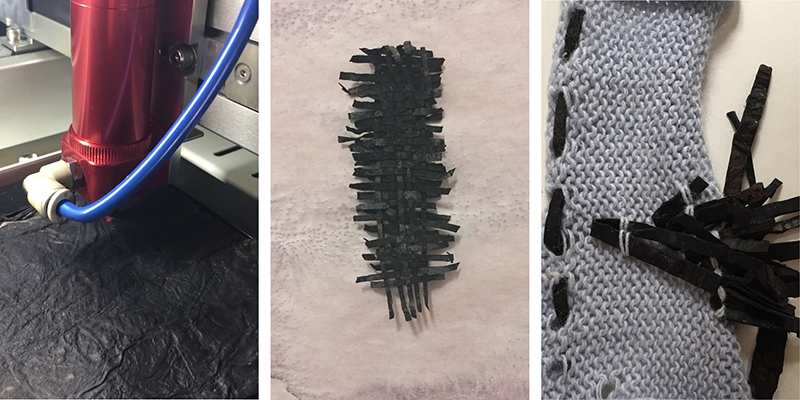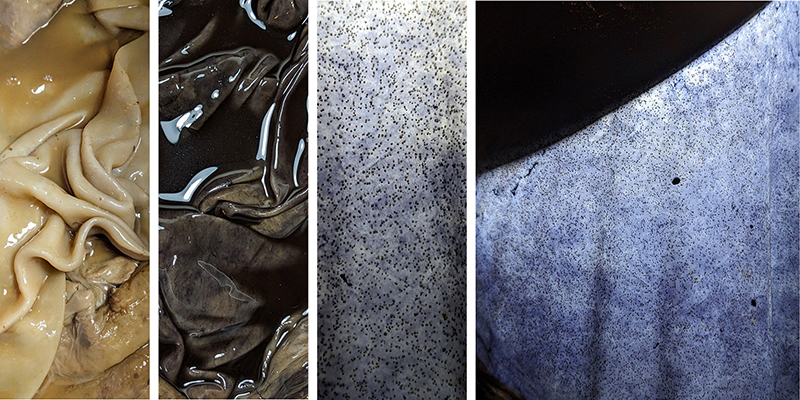Plain SCOBY¶
SCOBY dye¶
Research made with Lauriane Beaumont. Following the week 4 of Biochromes. We would like to test on the Scoby.
| Material | Details |
|---|---|
| Ingredients | Scoby of kombucha, Ink with Ethanol, Natural bath of dying, Iron, Soda ash, Glycerol |
| Tools | Balance, Spoon, Porous surface |
Scoby crepes, bend 03/02/2023 - 05/02/2023"¶

| Microbial species | Origine | Feedstock | Drying method | Post traitment |
|---|---|---|---|---|
| SCOBY of Kombucha | Pierre and Charles « La Pieuvre Noire kombucha», Lyon | Ink with Ethanol, Natural bath of dying, Iron, Soda ash | Natural drying | Glycerol |
Add a fabric below the plain Scoby.
Draw on the scoby with natural ink, ethanol ink, soda ash, iron sulfate.
The SCOBY was folded in on itself, like a triangle crepes. For finally be a rectangle.
After fews days of drying when was between dry on humid state, we had glycerol on it. The iron change completely the color of the globality of the SCOBY.
In this first test we discover the impact of the iron, soda ash and the reaction with the different bath of color.

- Drawing on the SCOBY with campeche bath
- Seeing the impact of Iron making a tatoo on the SCOBY
- Final result of the rectangle with glycerol on it

| Laser settings | Details | |
|---|---|---|
| Cutting | Puissance | Vitesse |
| 80 | 4 |
Dying in mass¶

| Microbial species | Origine | Feedstock | Drying method | Post traitment | Application |
|---|---|---|---|---|---|
| SCOBY of Kombucha | Pierre and Charles « La Pieuvre Noire kombucha», Lyon | Campeche bath + iron | Natural drying | Glycerol | Piece of art: exhibition Lauriane Beaumont |
Add the scoby inside the dying bath
Add iron for having more deeper color
Wringer the scoby
Let put on the fabric
Wait till dry
Adding glycerol
Post traitement¶
- Moulding with layers on SCOBY
Results and remarks¶
Colors application
The unmixed scoby **does not require mordanting or alluning** unlike the usual textile dyes.
The color can be applied directly to the flat surface like a canvas. There is also the possibility to dye it in the mass. We notice that sandalwood powder has a hard time to take and the dye powder stays outside the scoby. The iron color baths allow to mark more the color on the scoby. Turmeric ethanol with bicarbonate causes an orange red. The dye color applied to the scoby has a tendency to run through it. The color disgorges by applying a textile underneath it is possible to create the effect of a double canvas. The eco print with St. John’s wort did not work well. The fibers of the plant stick to the scoby.
Colors tips discover
The scoby make a reaction of the grain of soda ash and iron sulfate. This made like a fine pigments inside. When you mix curcuma ethanol mixture with soda ash this create a red color. The color dye better when you add iron sulfate of our bath of campeche. The color stay more in the scoby and she is more deep.
Changing the thickness and solidity
To change its thickness and make it more solid, it is possible to fold the scoby on itself. It creates a glue with itself. If the scoby is too dry, rewet it with a bit of water. The scoby can easily become very thin and brittle depending on its initial thickness.
Drying
It is recommended to work the plan scoby: - on a material that drinks the humidity. It is possible to turn it over to homogenize the drying process. - It is possible to turn it over to homogenize the drying process - It is possible to add glycerol with a brush or by hand on the fragile areas once it has begun to dry.
Specificity and technical characteristics
Depending on its wet or dry state, we have noticed changes in colors, textures, thicknesses, etc. The thicker the stump, the stronger it will be when drying. Once dry, the scoby take easily the water. Too much glycerin makes it very soft with a sticky texture.